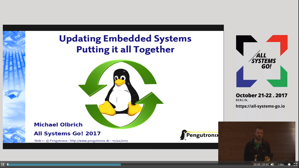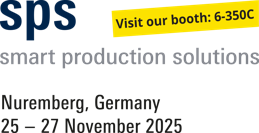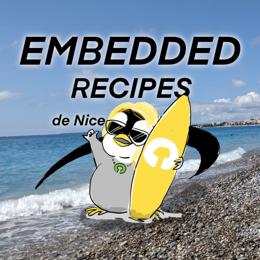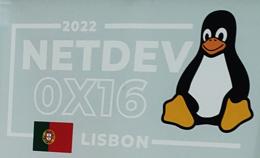All Systems Go 2017: Updating Embedded Systems
At the All Systems Go conference in Berlin, Michael Obrich reported at 2017-10-22 about "Updating Embedded Systems - Putting it all together", based on the experiences of the Pengutronix integration team.
While some years ago embedded systems have almost never been updated, the recent IoT security incidents started to make the device manufacturers think about how to bring new software to their embedded devices. Many Linux systems implement an "A/B" scheme, consisting of two system software slots. One is currently running and an update is written to the currently-unused slot. This mechanism can be implemented in an "atomar" way, so even a failure in the update process cannot brick the system.
Besides writing the actual update (being more or less generic), there is another important task: the functionality of the updated system needs to be checked against possible errors. In case something went wrong, interactive devices have the possibility to show a related message on the screen, giving the user the option to switch back to the old software. The same concept works for non-interactive systems which are controlled by a rollout server. Completely unattended systems are a more difficult case: there is the possibility to use the watchdog to supervise the startup procedure; after the kernel has booted, systemd can be used as the watchdog handler. While in normal desktop usecases systemd falls back to a shell in case of an error, non-interactive embedded usecases need to take additional effort to supervise its applications correctly:
- The system can try to boot a 2nd time in case of an error, counting the boot attempts in the bootloader (i.e. barebox). When the reboot counter reaches a limit, the system can do an automatic fallback to the old version.
- In case of transient errors, this mechanism can run in a loop.
- For more safety critical systems, the device can be brought into a safe state and shutdown in case of an error.
Usually the exact setup is highly project specific.
The infrastructure for writing updates and taking care of the software slots is often implemented with RAUC in our projects; RAUC is a sophisticated tool that can check cryptographical signatures or update the boot slots while transferring minimal data by using the new casync mechanism.
Further Readings
Pengutronix at SPS in Nuremberg
After some years of absence, Pengutronix is back at the SPS 2025 in Nuremberg. You will find us in hall 6, booth 6-350C. We are looking forward to connecting with old and new friends, partners and customers. As usual, we will be showcasing demonstrators on current topics at our exhibition stand.
GStreamer Conference 2025
This years GStreamer conference was held at the end of Oktober in London, UK. Since GStreamer is our goto-framework for multimedia applications, Michael Olbrich and me were attending this years conference to find out what's new in GStreamer and get in touch with the community.
Talks, Workshops, Time at the Beach - Embedded Recipes 2025
I was part of a small delegation of Pengutronixians at the Embedded Recipes conference this year in Nice, France. We had a great time there, so let's take a look back at the great talks we have seen, the labgrid workshop we held and our time in Nice in general.
Netdevconf 0x16
After a longer time with online-only events, the Netdev 0x16, a conference about the technical aspects of Linux Networking, was organized as hybrid event: online and on-site at Lisbon.
CLT-2022: Voll verteilt!
Unter dem Motto "Voll verteilt" finden die Chemnitzer Linux Tage auch 2022 im virtuellen Raum statt. Wie auch im letzten Jahr, könnt ihr uns in der bunten Pixelwelt des Workadventures treffen und auf einen Schnack über Linux, Open Source, oder neue Entwicklungen vorbei kommen.
Wir haben doch etwas zu verbergen: Schlüssel mit OP-TEE verschlüsseln
Moderne Linux Systeme müssen häufig zwecks Authentifizierung bei einer Cloud- basierten Infrastruktur oder einer On-Premise Maschine eigene kryptografische Schlüssel speichern. Statt der Verwendung eines Trusted Platform Modules (TPM), bieten moderne ARM Prozessoren die TrustZone-Technologie an, auf deren Basis ebenfalls Schlüssel oder andere Geheimnisse gespeichert werden können. Dieses Paper zeigt die Nutzung des Open Portable Trusted Execution Environments (OP- TEE) mit der Standardkonformen PKCS#11 Schnittstellen und i.MX6 Prozessoren von NXP als Beispiel.








